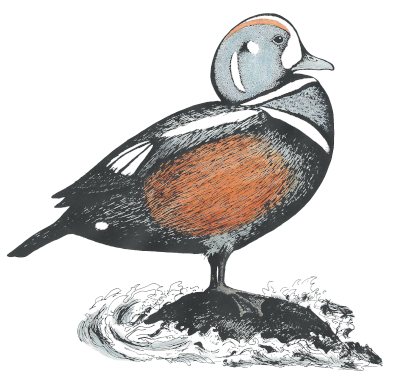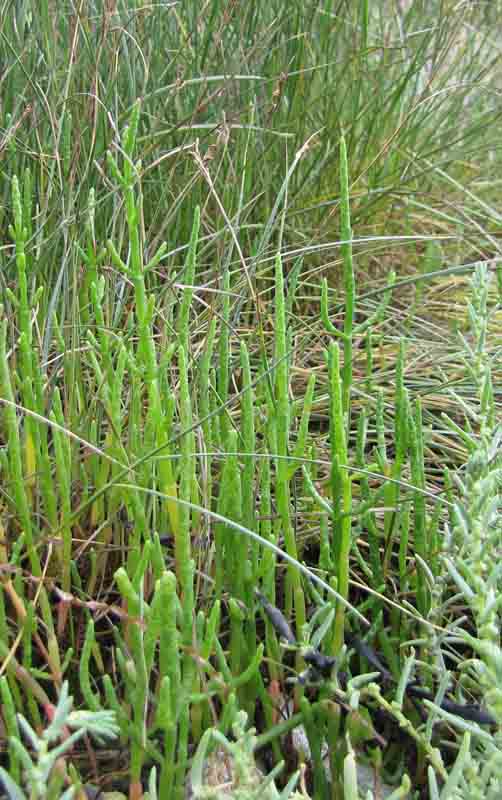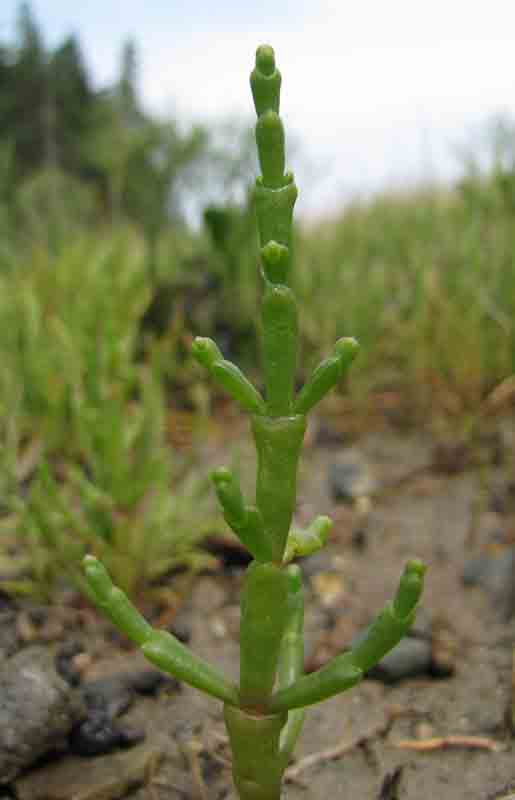
Amaranthaceae - amaranth family
petals: 0
Maine is home to 44 species in 15 genera that grow without cultivation. If you already know which species you have or are interested in learning about, click on the appropriate species link below. Otherwise, to determine which genus that the plant in question belongs to, refer to the table immediately below the species list.
Amaranthus (6 species)
Amaranthus albus - tumbleweed amaranth
Amaranthus blitoides - prostrate amaranth
Amaranthus cannabinus - salt marsh water-hemp
Amaranthus hybridus - green amaranth
Amaranthus retroflexus - red-rooted amaranth
Amaranthus tuberculatus - rough-fruited water-hemp
Atriplex (6 species)
Atriplex acadiensis - maritime orache
Atriplex glabriuscula - bracted orache
Atriplex littoralis - linear-leaved orache
Atriplex patula - spreading orache
Atriplex prostrata - hastate-leaved orache
Atriplex subspicata - saline orache
Axyris (1 species)
Axyris albus - Russian-pigweed
Bassia (2 species)
Bassia hyssopifolia - five-horned smotherweed
Bassia scoparia - firebush smotherweed
Beta (1 species)
Beta vulgaris - beet
Blitum (4 species)
Blitum bonus-henricus - perennial orache-goosefoot
Blitum capitatum ssp. capitatum - strawberry orache-goosefoot
Blitum nuttalliana - Nuttall’s orache-goosefoot
Blitum virgatum ssp. virgatum - leafy orache-goosefoot
Chenopodiastrum (2 species)
Chenoposiastrum murale - nettle-leaved false goosefoot
Chenoposiastrum simplex - giant-seeded false goosefoot
Chenopodium (6 species)
Chenopodium album - white goosefoot
Chenopodium berlandieri - pit-seeded goosefoot
Chenopodium betaceum - oval-seeded goosefoot
Chenopodium foggii - Fogg’s goosefoot
Chenopodium leptophyllum - narrow-leaved goosefoot
Chenopodium pratericola - desert goosefoot
Dysphania (3 species)
Dysphania ambrosioides - Mexican-tea
Dysphania botrys - Jerusalem-oak
Dysphania graveolens - fetid glandular-goosefoot
Lipandra (1 species)
Lipandra polysperma - manyseed goosefoot
Oxybasis (3 species)
Oxybasis glauca ssp. glauca - oak-leaved Eurasian-goosefoot
Oxybasis rubra - red Eurasian-goosefoot
Oxybasis urbica - city Eurasian-goosefoot
Salicornia (3 species)
Salicornia bigelovii - dwarf glasswort
Salicornia depressa - common glasswort
Salicornia maritima - sea glasswort
Salsola (2 species)
Salsola kali - saltwort
Salsola tragus - prickly saltwort
Spinacea (1 species)
Spinacea oleracea - spinach
Suaeda (3 species)
Suaeda calceoliformis - American sea-blite
Suaeda linearis - annual sea-blite
Suaeda maritima - herbaceous sea-blite
| red font = unique character state or nearly so | leaf arrangement | leaf morphology | petiole base | stem roughness |
| Amaranthus | alternate | expanded blade with distinct petiole | petiole base clasps stem | may or may not be rough |
| Atriplex | alternate and/or opposite | expanded blade with distinct petiole | petiole base narrow, does not clasp stem | may or may not be rough |
| Axyris | ||||
| Bassia | ||||
| Beta | ||||
| Blitum | ||||
| Chenopodiastrum | ||||
| Chenopodium | alternate | expanded blade with distinct petiole | petiole base narrow, does not clasp stem | not rough |
| Dysphania | ||||
| Lipandra | ||||
| Oxybasis | ||||
| Salicornia | opposite | scale-like, no petiole | n/a (no petiole) | not rough |
| Salsola | ||||
| Spinacea | ||||
| Suaeda | alternate | linear, no petiole | n/a (no petiole) | not rough |
Amaranthus (amaranth)
Etymology: The name of this genus comes from the Greek (second declension neuter) noun amaranton (αμαραντον) for “never-fading flower”, referring to the “dry, unwithering bracts”2. The Latin noun amarantus is masculine (second declension), hence the (nominative singular) masculine specific epithets, which are here adjectives.
| red font = unique character state or nearly so | bract length | apex of sepals of carpellate flowers | curvature of upper portion of sepals of carpellate flowers |
| A. albus | |||
| A. blitoides | |||
| A. cannabinus | |||
| A. hybridus | 3–4 mm | (sub)acute | not outwardly curved |
| A. retroflexus | 4–8 mm | obtuse to emarginate | outwardly curved |
| A. tubercuatus |
Amaranthus albus (tumbleweed amaranth) - [information to be added]
Amaranthus blitoides (prostrate amaranth) - [information to be added]
Amaranthus cannabinus (salt marsh water-hemp - [information to be added]
Amaranthus hybridus (green amaranth) has been reported in Maine from Hancock and Waldo Counties and from York, Cumberland, and Oxford Counties. It has been reported from scattered counties in New Hampshire and Vermont, and from most counties of Massachusetts, Rhode Island, and Connecticut.
Amaranthus retroflexus (red-rooted amaranth) has been reported from all counties in Maine and almost all in New England. The early season shoots, later leaves, and finally seeds are “important and nutrient-dense foods”3.
Amaranthus tuberculatus (rough-fruited water-hemp) - [information to be added]
Atriplex (orache)
[information to be added]
| red font = unique character state or nearly so | extent of leafy bracts in inflorescence | shape of brown fruits | abundance of black fruits | habitat |
| A. acadiensis | only at base | more or less round | common | salt marshes, sea beaches |
| A. glabriuscula | nearly to tip | {?} | rare or absent | salt marshes, sea beaches |
| A. littoralis | ||||
| A. patula | only at base | more or less round | common | roadsides, waste areas |
| A. prostrata | only at base | more or less round | common | salt marshes, sea beaches |
| A. subspicata | only at base | elliptic (wider than long) | common | salt marshes, sea beaches |
Atriplex acadiensis (maritime orache) - [information to be added]
Atriplex glabriuscula (bracted orache) - [information to be added]
Atriplex littoralis (linear-leaved orache) - [information to be added]
Atriplex patula (spreading orache) - rare on Mount Desert Island
Atriplex prostrata (hastate-leaved orache) - [information to be added]
Atriplex subspicata (saline orache) - [information to be added]
Axyris ([?])
[information to be added]
Axyris amaranthoides (Russian-pigweed) - [information to be added]
Bassia ([?])
[information to be added]
| char. 1 | char. 2 | |
| B. hyssopifolia | ||
| B. scoparia |
Bassia hyssopifolia (five-horned smotherweed) - [information to be added]
Bassia scoparia (firebush smotherweed) - [information to be added]
Beta (beet)
[information to be added]
Beta vulgaris (beet) - [information to be added]
Blitum (orache-goosefoot)
[information to be added]
| red font = unique character state or nearly so | char. 1 | char. 2 |
| Blitum bonus-henricus | ||
| B. capitatum ssp. capitatum | ||
| B. nuttallianum | ||
| B. virgatum ssp. capitatum |
Blitum bonus-henricus (perennial orach-goosefoot) [information to be added]
Blitum capitatum ssp. capitatum (strawberry orache-goosefoot) [information to be added]
Blitum nuttallianum (Nuttall’s orache-goosefoot) [information to be added]
Blitum virgatum ssp. virgatum (leafy orache-goosefoot) [information to be added]
Chenopodiastrum (false goosefoot)
[information to be added]
| char. 1 | char. 2 | |
| C. murale | ||
| C. simplex |
Chenopodiastrum murale (nettle-leaved false goosefoot) [information to be added]
Chenopodium simplex (giant-seeded false goosefoot) [information to be added]
Chenopodium (goosefoot)
[information to be added]
| red font = unique character state or nearly so | sepal number | habit |
| C. album | consistently 5 | erect |
| C. berlandieri | ||
| C. betaceum | ||
| C. fogii | ||
| C. leptophyllum | ||
| C. pratericola |
Chenopodium album (white goosefoot) [information to be added]
Chenopodium berlandieri (pit-seeded goosefoot) [information to be added]
Chenopodium betaceum (oval-seeded goosefoot) [information to be added]
Chenopodium foggii (Fogg’s goosefoot) [information to be added]
Chenopodium leptophyllum (narrow-leaved goosefoot) [information to be added]
Chenopodium pratericola (desert goosefoot) [information to be added]
Dysphania (glandular goosefoot)
[information to be added]
| red font = unique character state or nearly so | char. 1 | char. 2 |
| D. ambrosioides | ||
| D. botrys | ||
| D. graveolens |
Dysphhania ambrosioides (wormseed) [information to be added]
Dysphania botrys (crested glandular-goosefoot) [information to be added]
Dysphania graveolens (fetid glandular-goosefoot) [information to be added]
Lipandra (manyseed-goosefoot)
[information to be added]
Lipandra polysperma (manyseed-goosefoot) - [information to be added]
Oxybasis (Eurasian-goosefoot)
[information to be added]
| red font = unique character state or nearly so | char. 1 | char. 2 |
| O. glauca ssp. glauca | ||
| O. rubra | ||
| O. urbica |
Oxybasis glauca ssp. glauca (oak-leaved Eurasian-goosefoot) [information to be added]
Oxybasis rubra (red Eurasian-goosefoot) [information to be added]
Oxybasis urbica (city Eurasian-goosefoot) [information to be added]
Salicornia (glasswort)
Etymology: Salicornia is derived from two Latin words: sal, salis, salt (from its saline habitat); and cornu, cornus, horn (from the horn-like appearance of its branches)1.
| red font = unique character state or nearly so | char. 1 | char. 2 |
| S. bigelovii | ||
| S. depressa | ||
| S. depressa |
Salicornia bigelovii (dward glasswort) [information to be added]
Salicornia depressa (common glasswort) - [information to be added]


(click on an image to enlarge)
Salicornia maritima (sea glasswort) [information to be added]
Salsola (saltwort)
[information to be added]
| char. 1 | char. 2 | |
| S. kali | ||
| S. kali |
Salsola kali (saltwort) [information to be added]
Salsola tragus (prickly saltwort) [information to be added]
Spinacea (spinach)
[information to be added]
Spinacea oleracea (spinach) [information to be added]
Suaeda (sea-blite)
[information to be added]
| red font = unique character state or nearly so | habit | relative size of sepals at maturity | anther length | seed width |
| S. calceoliformis | erect to decumbent | unequal | 0.3–0.4 mm | 0.8–1.7 mm |
| S. linearis | erect | equal | approximately 0.2 mm | 1.0–1.8 mm |
| S. maritima | prostrate to erect | equal | [?] | 1.0–2.2 mm |
Suaeda calceoliformis (American sea-blite) [information to be added]
Suaeda linearis (annual sea-blite) - [information to be added]
Suaeda maritima (herbaceous sea-blite) - [information to be added]

(click on image to enlarge)
Notes:
1Britton, Nathaniel Lord, and Addison Brown. 1896, volume I, page 582. An Illustrated Flora of the Northern United States, Canada and the British Possessions. New York: Charles Scribner’s Sons.
2Britton, Nathaniel Lord, and Addison Brown. 1896, volume I, page 587. An Illustrated Flora of the Northern United States, Canada and the British Possessions. New York: Charles Scribner’s Sons.
3Haines, Arthur. 2015. Ancestral Plants, volume 2.